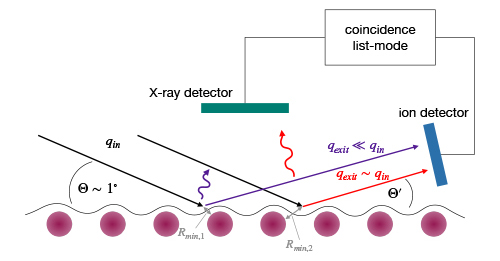Team
- Permanent members Martino Trassinelli, Christophe Prigent, Emily Lamour, Sébastien Steydli, Stéphane Macé, Dominique Vernhet
- PhD Student: Perla Dergham (2020-2023)
This project aims for basic research in Atomic Physics and Materials Science and bridging the gap to application for newly emerging two-dimensional magnets. On the one hand, we want to study the fundamental interaction between highly charged ions and magnetically ordered surfaces. On the other hand, we will apply knowledge acquired on ion–surface interaction to the investigation of magnetic properties of the very first atomic layers of bulk materials, thin films, and magnetic 2D materials.

Figure 1: Sketch of a collision between a highly charged ion under grazing angle. Depending on the particular trajectory different minimal inter-particle distances are probed, which can be distinguished by the exit charge state. X- rays measured in coincidence allows to probe the electron occupancy of the free hollow atom formed in the collision.
At sub-MeV energies, ion–surface collisions are characterized by multiple capture of electrons from the sample surface to the projectile ions. As soon as the Coulomb barrier between the ion and surface electric potential is lower than the surface work function, which corresponds generally to a few Å above the surface, the electrons are resonantly transferred from the surface to high-n excited states of the ion in less than a femtosecond. Just above the sample surface, an almost (or completely) neutralized multiply excited atom with electron vacancies in the core shells is formed. It is commonly referred to as a hollow atom. The atom subsequently de-excites by internal Auger, interatomic Auger, and radiative de-excitation. For high-n excited levels, non-radiative Auger processes and especially the interatomic Auger process (also known as interatomic Coulomb desecxitation) are dominant compared to radiative processes. However, it was shown earlier, that inner shell vacancies of highly charged ions survive for a relatively long time and subsequently high energy photons as a result of radiative decay can be observed as well.
Because of the electron capture above the surface, the processes involved are sensitive to the first atomic layers of the sample. In general, electrons populate statistically the ion excited states, independently of their total spin number S. S is conserved during the radiative de-excitation cascade and kept maximum through internal Auger transitions. In cases of surfaces presenting a ferromagnetic phase, the electron spin alignment favors the population of ion excited states with a large S value. The presence of antiferromagnetic order will, on the opposite, favors singlet spin states with S = 0. Measurement of characteristic radiation emitted from the de-excitation of atomic states with different S should then permit to obtain information on the magnetic order of the considered sample.
The experiments runs at the SIMPA installation at INSP and at the TU Wien institute in Austria. For this purpose, at INSP two ultra-high vacuum chambers have been designed, constructed and equipped (for more details, click here). In particular, the interaction chamber has a 6-axis goniometer to finely control the ion–surface collision geometry.
Collaborations
- INSP, Growth and properties of hybrid thin film systems team (M. Marangolo)
- Atomic and Plasma Physics group of TU Wien.
From February 2021, this research line will be developed within the DIMAS international ANR project (2021-2024).

